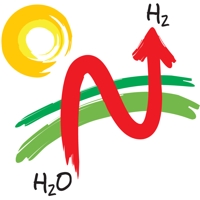
Plant Biochemistry, Faculty of Biology & Biotechnology, Ruhr-University Bochum, Universitätsstr. 150, 44780 Bochum, Germany
e-mail: matthias.roegner@rub.de

 |
Matthias Rögner
Plant Biochemistry, Faculty of Biology & Biotechnology, Ruhr-University Bochum, Universitätsstr. 150, 44780 Bochum, Germany e-mail: matthias.roegner@rub.de |
 |
In order to produce hydrogen as potential future renewable energy source from water, we propose to engineer cyanobacterial photosynthesis towards increased bioenergy instead of biomass production. Besides the implementation of a highly active, oxygen tolerant hydrogenase from other organisms such as green algae (this requires a special strategy...), especially the photosynthetic electron metabolism has to be engineered in many individual steps towards this goal. The result of each single engineering step (such as antenna size reduction, partial uncoupling of the thylakoid membrane, re-routing of electrons at the photosystem 1 acceptor site) has to be monitored by both functional (for instance spectroscopy) as well as metabolic characterization on the whole cell level (for instance by an in depth quantitative proteome, lipidome- and metabolome analysis). The direction of engineering is supported by studying protein-protein-interactions in isolated model systems – for instance the affinity of Ferredoxin (Fd) for Ferredoxin-NADP-Oxidoreductase (FNR) vs. hydrogenase, which is a decisive step for re-routing electrons from water for hydrogen production instead of CO2-fixation.
Performance of such engineered cells has to be optimized by improving fermentation conditions and by an optimal photobioreactor design. Optimal culture conditions can be found and kept constant for several months by using continuous flow fermentation techniques which allow the systematic optimization of each individual parameter. Provided such systems are optimized both on the individual cell level and on the systems level, a more than 100-fold increase of hydrogen production in comparison with the most productive natural systems existing to date can be estimated, which would be a promising basis for an economically competitive H2-production.